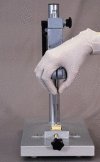Deflection of mini implants from its intended path of placement on varying bone densities
- PMID: 36601239
- PMCID: PMC9799994
- DOI: 10.4317/jced.59903
Deflection of mini implants from its intended path of placement on varying bone densities
Abstract
Background: Knowledge of bone density in maxilla and mandible will allow the clinician to plan the anchorage strategies and placement of implants with necessary precautions. The study aims to evaluate the deflection changes of titanium alloy self-drilling mini implants from the intended path that occurs during placement in varying bone densities.
Material and methods: 63 titanium alloy self-drilling mini implants of the lengths 6mm, 8mm, and 10mm with diameter of 1.3mm were placed in three homogenous solid rigid polyurethane foam (saw bone) with bone densities of 20pcf, 30pcf, and 40pcf simulating anatomic sites in maxilla and mandible. 7mini implants of each length in all bone densities were tested for study. The implants were inserted perpendicularly into artificial bone block held in a custom made stand. The bone blocks were then radiographically exposed and the deviation of the long axis of the implantfrom a true vertical line was measured.
Results: There was a decrease in deflection of the mini implant with increase in density. On the other hand, increase in length resulted in increase in the amount of deflection.
Conclusions: Longer mini implants can be used in less dense bone as in maxilla, whereas shorter mini implants can be used in high dense bone as in mandible to increase the stability and success rate of implants. Bone density and implant length play a role in deflection of mini implant from its intended path of insertion. Key words:Orthodontic Mini implants, deflection, bone density, anchorage.
Copyright: © 2022 Medicina Oral S.L.
Conflict of interest statement
Conflicts of interest Non declared.
Figures




Similar articles
-
Effect of placement angle, diameter, length and bone density on the pull-out strength of orthodontic mini-implants: An in vitro study.J Orthod. 2022 Jun;49(2):143-150. doi: 10.1177/14653125211053338. Epub 2021 Oct 20. J Orthod. 2022. PMID: 34666551
-
Microdamage of the cortical bone during mini-implant insertion with self-drilling and self-tapping techniques: a randomized controlled trial.Am J Orthod Dentofacial Orthop. 2012 May;141(5):538-46. doi: 10.1016/j.ajodo.2011.12.016. Am J Orthod Dentofacial Orthop. 2012. PMID: 22554747
-
Insertion Torques of Self-Drilling Mini-Implants in Simulated Mandibular Bone: Assessment of Potential for Implant Fracture.Int J Oral Maxillofac Implants. 2016 May-Jun;31(3):e57-64. doi: 10.11607/jomi.4427. Int J Oral Maxillofac Implants. 2016. PMID: 27183083
-
Anchorage and Stability of Orthodontic Mini Implants in Relation to Length and Types of Implants.Cureus. 2024 Nov 5;16(11):e73056. doi: 10.7759/cureus.73056. eCollection 2024 Nov. Cureus. 2024. PMID: 39640137 Free PMC article. Review.
-
Temporary anchorage devices (TADs) in orthodontics: review of the factors that influence the clinical success rate of the mini-implants.Clin Ter. 2016 May-Jun;167(3):e70-7. doi: 10.7417/CT.2016.1936. Clin Ter. 2016. PMID: 27424513 Review.
Cited by
-
Development and in vitro testing of an orthodontic miniscrew for use in the mandible.J Orofac Orthop. 2025 Aug;86(Suppl 1):100-110. doi: 10.1007/s00056-024-00560-z. Epub 2024 Nov 26. J Orofac Orthop. 2025. PMID: 39589499 Free PMC article.
References
-
- Proffit WR, Fields Jr HW, Sarver DM. Contemporary orthodontics. Elsevier Health Sciences; 2006.
-
- Buschang PH, Carrillo R, Ozenbaugh B, Rossouw PE. 2008 survey of AAO members on miniscrew usage. Journal of clinical orthodontics: JCO. 2008;42:513–8. - PubMed
-
- Wilmes B, Rademacher C, Olthoff G, Drescher D. Parameters affecting primary stability of orthodontic mini-implants. Journal of Orofacial Orthopedics/Fortschritte der Kieferorthopädie. 2006;67:162–74. - PubMed
-
- Baumgaertel S, Hans MG. Buccal cortical bone thickness for mini-implant placement. American Journal of Orthodontics and Dentofacial Orthopedics. 2009;136:230–5. - PubMed
-
- Farnsworth D, Rossouw PE, Ceen RF, Buschang PH. Cortical bone thickness at common miniscrew implant placement sites. American Journal of Orthodontics and Dentofacial Orthopedics. 2011;139:495–503. - PubMed
LinkOut - more resources
Full Text Sources
